Introduction by Beezone
It would seem impossible to cook a scrambled egg using a hammer, but that is precisely the method language and logic uses to ‘evaluate’ the self-proclaimed (or others’ claims) of someone’s level or degree of spiritual enlightenment.
I mean in no way to disparage David Lane‘s scholarly attempt to do just that, but as he points out in the following article, to evaluate or make a conclusion about Adi Da Samraj (Da Free John) (or anyone for that matter) “without any direct personal observation of Da Free John, nor any experiential involvement with his methodology” not only paradoxical but naive and a sign of immaturity. David’s essay below is an excellent one – even after 26 years since its publication – demonstrating my point.
Firstly, as David rightly points out, there is no way to ‘prove’ or ‘justify’ Adi Da’s grandiose claims about ‘his’ realization. But it would also be naive and careless to dismiss them outright solely because they are beyond your level of comprehension and they offend you. I’m not going to try and ‘argue’ or ‘logically’ prove or justify anything about Adi Da Samraj, his writing, or his life. Nor could I any more than I could prove or demonstrate a need to explain my love for my wife to anyone – nor should you. But it is essential, at least, to get the “story” right if we discuss matters as necessary as the ones David and Adi Da write about.
Before I go into the limits of David’s article below, I must point out the limitations and frustrations inherent in David’s attempt. In the article, David refers to several influential writers, Georg Feuerstein, Ken Wilber, Donald Evans, and Fred Alan Wolf. Of those names, including David’s, only three have seen Adi Da Samraj. Getting into an academic swosh-buckling haggle based on someone’s writing is like, as David points out, trying to “judge a book by its cover.”
The serious reader should carefully stay with me as I critically examine David’s article, which follows, for it brings up an ongoing misconception that has existed for over 40 years. However, the smartest think they are.
The following is a segmented portion of an article published in
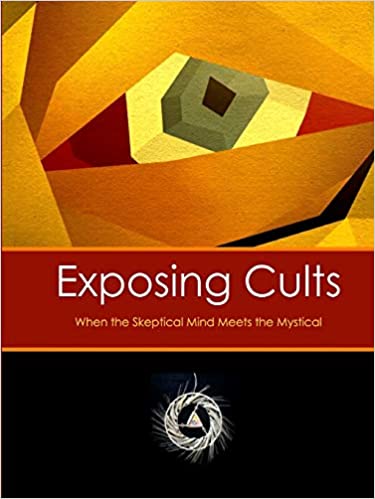
EXPOSING CULTS: WHEN THE SKEPTICAL MIND CONFRONTS THE MYSTICAL
David C. Lane
Garland Publishing, Inc. (1994)
Chapter One
THE PARADOX OF DA FREE JOHN
Distinguishing the Message from the Medium
***
(Beezone COMMENTS are in CAPITAL LETTERS)
There are very few spiritual teachers in the 20th century who could be termed religious geniuses. Da Free John is one of them.
(BEEZONE: IT SHOULD BE NOTED THAT AT THE END OF THIS ESSAY DAVID CHANGES HIS TUNE – AND DOES SO INTO THE FUTURE ).
Since the beginning of his formal ministry in 1972 in southern California, Da Free John has produced a body of work which is unparalleled amongst new religious thinkers for its radical insight, comparative depth, and force of expression. He has won wide critical acclaim for his writings, eliciting praises from sociologists, psychologists, and theologians.
A number of individuals have rejected Da Free John’s sweeping and dynamic message on the grounds that he is just another cult leader out to gain followers, fame, and wealth.[8] Moreover, some readers just cannot countenance Da Free John’s “Crazy Adept” image. Across the years I have heard reactions that vary from: “He walks around half naked most of the time, wearing skimpy underwear.” “I dislike his writing style; it’s self aggrandizing.” “Why does he keep changing the name of his organization?” “He is a poser, the epitome of the guru hype of the late 1960’s. . . long hair, beard, walking staff, necklaces, then he shaves it all and goes for the egghead look. . . I don’t buy it.” “He has a hat/cap fetish.” “Doesn’t he drink his own urine?”[9]
Nevertheless, these same critics who disapprove of Da Free John’s demeanor also reject his writings in their entirety since a “cult leader cannot possibly have any true or substantial insights on the nature of reality.”[10]
This, I believe, is a tragic mistake.
(REMEMBER: DAVID CHANGES HIS TUNE)
The underlying spiritual message and the transmitting medium who conveys it, though related, are two distinct entities.
(THE MCLUHAN – MEDIUM/MESSAGE – WAS A COMMON THEME IN THE 70’s AND 80’s)
To confuse the two betrays the fact that a corrupt religious group can present genuine teachings, or, that an authentic spiritual discourse can have an illegitimate expression.
I remember an incident in the spring of 1984 at the school where I was teaching which typifies this issue. I suggested to one of my brightest students that he read Da Free John’s The Paradox of Instruction in order to get a better grasp of the varying yoga systems and their desired aims. The student took up my suggestion and casually mentioned the author and the book to his political science teacher, who, without a moment’s reflection, called Da Free John “pop,” implying that the guru had nothing really good to offer. When I heard of my colleague’s reaction I asked the student to query his teacher further and find out if he had ever seriously read Da Free John’s books. The answer, surprisingly, was no.[11]
Obviously, my colleague didn’t appreciate Da Free John’s guru portrayal, at least as it was depicted on the cover of his books. Yet, instead of stopping there and making a judgment call on Da Free John’s pictures, my teacher associate carried his opinion even further and applied it to his writings as well–though he himself had never studied them. The sad part about this sort of prejudice is that it reinforces the very thing that teachers of all backgrounds (including those from secondary schools) argue against: “Don’t judge a book by its cover.” “Let the facts speak for themselves.” Etc.
Quite simply, regardless of how we may view his “Crazy Adept” image, Da Free John is one of the best writers on the perennial wisdom (non-dualist philosophy) in North America.
As Donald Evans, Professor of Philosophy at the University of Toronto, comments:
I regard Da Free John as the most significant contemporary writer concerning the core of religion, more profound than Paul Tillich, Gabriel Marcel, and Martin Buber. Intimately acquainted with a vast range of spiritual experience, he peels off all externals and challenges us to join with him in surrender of our whole selves, shattering the egoism which contracts and separates us from participation in the loving, radiant life of God.[12]
Now that we have seen how people can confuse the medium with the message (castrating the latter merely on Da Free John’s appearance), let us turn our attention to how the reverse can also happen. Several prominent thinkers have hailed Da Free John as a God realized Adept, a Divine Incarnation, the Avatar for the Western world, primarily on the strength of his numerous written texts. The problem in some of these ecstatic eulogies, though, is that they have been made without any direct personal observation of Da Free John, nor any experiential involvement with his methodology.[13]
What is occurring in many of these instances is a mere verbal assessment of Da Free John as a master based not upon intimate contact with him but on discursive reading. “He writes so well on the ultimate truths he must be a genuine guru.” The danger in this approach is that we often end up measuring the competence of spiritual teachers exclusively on their ability to write or communicate well. Such a procedure is at best haphazard and inappropriately favors a left-brain inclination to religious leaders. If we judge masters in this way, and, no doubt, it should be an element in our appraisements, we leave ourselves open to an intellectual class of gurus versus a truly transformed group of enlightened men or women. A situation which, I would add, that has led to the erroneous claims about Alan Watts’ greatness. This, of course, is not to say that enlightenment and literacy are incompatible, but that the former should be adjudicated on evidence more than just the written word. There is no substitute for personal observation, involvement, or parallel experimentation.
It is readily apparent that some of the gracious praises for Da Free John’s mastership are really for his writings. Yet, because certain writers confuse the message with the medium, they automatically link the two presuming that if one speaks eloquently about the transcendental reality he must also be a Seventh Stage Sage. This is not necessarily so.[14]
The authenticity of a religious teacher, though partially open to rational appraisements, is determined by the personal engagement of the student in day to day practice, sadhana, abhyas, or zazen. To secure judgements on anything less must be viewed as possible indicators of the teacher’s status, not as final verdicts or endorsements.[15]
On the other hand of the scale, the legitimacy of a master’s presentation can, for the most part, be adjudicated on the rational-verbal plane, as such an appraisement is chiefly concerned with the manifestation of the teachings on this level.[16]
Hence, while one may disagree with Da Free John’s guru image (the presentation of his message on this plane), perhaps claiming that it has a low degree of legitimacy, no final judgement can be made on his authenticity until actual contact with him and/or his teachings is undertaken.[17]
(IT SHOULD BE NOTED THAT TO PUT ‘GURU’ INTO ANY FAVORABLE LIGHT IN WESTERN PHILOSOPHICAL OR CULUTRAL TERMS IS ALMOST IMPOSSIBLE CONSIDERED ITS MIND ORIENTATION TO LIFE – “FORGET ABOUT IT!”)
This important distinction between authenticity and legitimacy, and the medium and the message, I believe, has not been made by many of those familiar, albeit slightly, with Da Free John’s life and work. Either they dismiss Da Free John entirely because of his photographs or over hype him on the basis of his writings.
(NOTICE THE LEVEL OF ACCEPTANCE BEING USED – “APPEARANCE”)
Interestingly, Da Free John’s teachings or insight are not the controversial subject. Who, for instance, with any spiritual inclination, would deny that there is some greater power than ourselves? That we have two fundamental options in the face of this Great Mystery: surrender or recoil? Or, finally, that God is Love and demands by His very existence that we participate via sacrifice of the ego in His Being?
(DAVID GIVES THE EXISTENTIAL POINT OF RELATING TO ‘TRUTH’ – SURRENDER AND BECOME OR RECOIL AND AVOID AND DEFEND (PROTECT))
No, Da Free John’s message isn’t the cause for the debate surrounding him, it is his method of presentation, the legitimacy of his expression, which has turned admirers of his written word to harsh critics of his actions.[18]
(PRESENTATION – ACCEPTABILITY. CONFORMING TO ONES SENSIBILITIES)
Though there are really no good reasons to overlook Da Free John’s vast contribution to spiritual philosophy and practice, there are some very pertinent questions to pose with regard to the validity of his organizational approach.
(SANGHA – SATSANG)
Some viable criticisms that I have read or heard include: “His church charges money for membership; this automatically disqualifies it as a genuine spiritual movement by some standards. Do true gurus ask for money as a prerequisite for having audiences with them? Would Jesus request a donation?” “Da Free John has virtually no public ministry, save his contact with intimate disciples. This constitutes a cultic ring, a vicious circle wherein the legitimacy of the guru’s actions goes unquestioned. Every blunder is rationalized, justified, or clarified as a “lesson for the devotee.” “To be frank with you, though I am a follower of Da, I do get upset with how he is portrayed. Do we really need so many pictures of him?” “Personally, I find the Da to be more egotistical than causal. His constant use of `I,’ though employed transcendentally, is quite condescending, especially if we are all `already happy/enlightened’ anyway.
Moreover, Da Free John makes absolute claims about his enlightenment and his unique way of presenting the essential truths. In a sense, if you take his argument to its full consequences, there is only one truly enlightened guru on the planet: himself! Everyone, according to Da, has their fifth and sixth stage limitations, except of course, himself. I find this not only presumptious, but also an indication that it is not healthy to follow gurus who allege that they have attained something no other saint or yogi has.”[19]
As for myself, though I am also critical of Da Free John’s guru image and presentation (I have a resistance to any guru who charges money (A COMMON EGALITARIAN – EQUAL – FROM THE 19TH CENTURY DEMOCRATIC IDEAL) or makes personal claims about his own spiritual attainments.),[20] it does seem obvious to me that he is purposely invoking a parody of himself and all human teachers so that his reader/students may awaken from a purely intellectual persual of his teachings and be confronted with the power of radical transcendentalism. I must admit that I never know what quite to expect from a Da Free John publication.
One year he is Franklin Jones, one-time disciple of Swami Muktananda, apparently extending the message of Advaita Vedanta for the western world; the next year he is Bubba Free John, the Spiritual Master, wearing Jewish styled caps; and in another year he is Da, with long hair, staff, living in seclusion, bald like a Zen monk, apparently much heavier, and preaching from a new island in the South Pacific.”[21]
Da Free John is, without question, the most iconoclastic teacher I have encountered.
(READ: THE WAY THAT I TEACH – “The way that i teach is not the way I am, but the way I teach….Those who remain confounded by me, critical of me, have yet to see themselves…”)
Not that his fundamental teachings change (they haven’t), but that he continually upsets every model/label that he assumes. Da Free John is literally like a Cracker Jack surprise in the religious world. Just when you think that he has run out of new guises, Da Free John comes up with some bizarre clothing to startle you. [Check out the cover of his book, The Bodily Location of Happiness (2nd Edition),
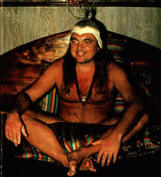
The picture of him on page 79 of The Laughing Man, Volume 4, Number 4,
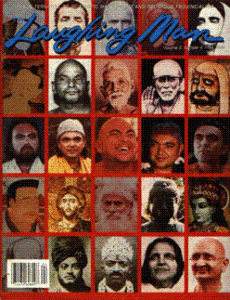
and the photograph of him in the book, Nirvanasara.]
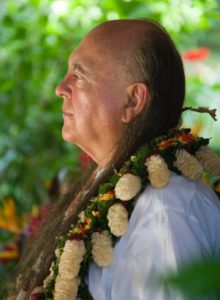
No wonder Da Free John has detractors calling him a cult weirdo; he invites such strong reactions by his selection of photographs.[22]
When Da Free John calls Seventh Stage Adepts crazy, he isn’t playing semantic words games. He means it structurally: bodily, mentally and spiritually in contrast to the “norm” of our society and unenlightened man.[23] His “transmission” or “portrayal,” depending on our estimation of his genuineness, upsets many of us, because true to his message Da Free John cannot adequately be pigeon-holed.
Now this doesn’t mean that we have to call him an enlightened being, or God-realized (can we really know if anyone is unless we ourselves are?),[24] (EXCELLENT POINT! THAT IS WHY ‘RECOGNITION’ IS SO IMPORTANT IN UNDERSTANDING ADI DA) but we shouldn’t dismiss him in light of his teachings, as his writings do have an important spiritual import. True, Da Free John is a paradox, but he is at least a contradiction who elicits further examination of our own relationship with Reality.[25]
(DAVID AT HIS BEST!)
Crazy Adepts and Sane Disciples
(THIS WHERE MOST PEOPLE LOSE IT!)
Master Da Free John is not on an “ego-trip”. Careful consideration will reveal that the ego that may be felt to arise while reading his writings is none other than the reader’s.
–Fred Alan Wolf, Ph.D.[54]
Regardless of the beauty of Radical Transcendentalism, one cannot help but encounter a strong sense of ego in Da Free John’s writings.
(OF COURSE, ANYONE WHO USES THE “I” REFERENCE WILL BE SEE AS AN EGO – SINCE THE BELIEF IN YOUNG AMERICA’S UNDERSTANDING OF ENLIGHTENMENT IS THAT THERE IS ‘NO’ EGO IN AN ENLIGHTENED STATE OF REALIZATION – IMPLING THAT THERE IS ‘NOTHING NOWHERE’. A COMMON AND UNDEVELOPED UNDERSTANDING).
Fred Alan Wolf in his Foreword to The Transmission of Doubt
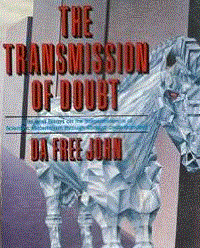
(see above excerpt) tries to explain this feeling away by arguing that it is the reader’s ego which arises when reading, not Da Free John’s. This statement, however, is logically inaccurate. For, given Wolf’s argument, the opposite corollary should also be true: When the reader does not feel ego, it is because he/she is egoless.[55]
No, the actual truth of the matter (something which Wolf picked up on and tried to explain away) is that Da Free John’s writings do reflect an egotistical stance. This is evident in his choice of language, the selection of photographs, the promotion of his exalted status, to finally the continuing advertising that his teaching is superior to any revelation prior to his advent. Da Free John may have transcended the ego and its constraints, but the presumptiousness of his books (vis-a-vis their style and promotion) is not simply due to the reader’s lack of spiritual attainment or misguided apprehension. To put the blame on seekers when the “ego arises” is naive. Rather, the more appropriate explanation is that Da Free John has chosen to present himself, his teachings, and his organization in a format which invites skepticism. Is it simply the reader’s ego which resists such Da Free John titles (essays and talks) as A Birthday Message From Jesus and Me?[56]
Though Da Free John alleges that he uses “I” and “Me” in a transcendental mode, its consistent use and juxtaposition with ultimate Reality has other effects. For instance, read the following excerpts from Da Free John’s recent essay, “Pondering and Preparation:”
The Way That I Teach is a Great Process. An Ordeal Of Self-Sacrifice to The Spiritual Form Of God. Many may Respond to My Offering, but some may need time to ponder and to prepare themselves. . . Those who find themselves in such a stage of Response to Me should not feel that they must remain apart from Me and the Fellowship. They should honor their Response to Me by becoming friends, patrons, and regular students of The Laughing Man Institute. . . Such individuals “ponder” by engaging the sadhana of Listening to Me. . . by pondering My Arguments and Responding to My Person. Therefore, active patronage, friendship, student participation, and beginner’s discipline are in fact forms of real practice. . . honored by The Fellowship.[57]
Perhaps the real “crisis” point at issue here is not only how one responds to the message of Radical Transcendentalism, but how one accepts Da Free John’s transmission of the same. For those receptive to the “Crazy Wisdom Tradition,” Da Free John’s authentic voice may be sufficient for allegiance to his ministry. As James Steinberg explains:
Because the Adepts are moved to immune and instruct whatever is brought before them, they may appear wild. They may appear self-indulgent, seem mad with powers, or act like fools. They may remain silent, or may teach through discourse or song, may appear angry, or warm, open, and loving. Historically, no two such Adepts were alike. Some practiced celibacy, and some were sexually active. For example, Marpa had one legal wife and eight Tantric consorts or partners. Yet his disciple Milarepa was naturally moved to be celibate… .[58]
The Paradox of Da Free John
Unquestionably, Da Free John has presented a number of superb works on spirituality with unique vigor and insight, deserving of deep attention and respect. Yet, how one responds to Da Free John as a spiritual master depends upon a number of contingent factors, not the least of which concerns the connection between legitimacy and authenticity. In the final analysis, critical examination, while it is both beneficial and necessary, can only lead so far. Ultimately, the relationship between a guru and a disciple must result from a force beyond (but not necessarily versus) the rational mind. In the midst of that power, in the “fire” of that impulse, the student can test both the sincerity of his surrender and the genuineness of his master.
Thus, the paradox of Da Free John is in some ways the paradox of the disciple: an intricate koan between outward and inward signals. Perhaps the greatest irony of all is that for a master who writes so much about transcending ego, Da Free John should be labeled by a number of readers as an “egotist.” But, even though we may not accept Da Free John’s claim for mastership, we can at the very least benefit significantly from his writings, which convey truths so universal and penetrating that there can be no debate.[61]
Postscript
“THE JERRY SPRINGER SHOW’
A few days after The Paradox of Da Free John was published in the early part of 1985, the San Francisco Chronicle and other Bay Area newspapers published an extensive expose of the guru’s sexual exploits and violent interplays with female disciples.
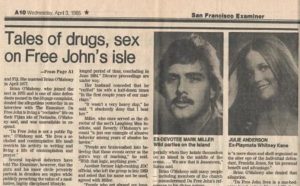
It was a significant blow to the group; some defectors even claimed that Da Free John had seven wives (the numbers vary, depending on the defector) and that he occasionally beat one of his wives. He is also reported to have had an alcohol and drug problem.
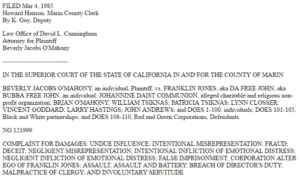
(FOR MORE THAN A SPECTATORS VIEW OF THIS PERIOD OF TIME. READ THE FOLLOWING FROM ‘JULIE ANDERSON’ – THE PLAYBOY CENTERFOLD – ABOUT THIS PERIOD OF TIME IN THE HISTORY OF ADI DA AND HIS COMMUNITY – JULIE ANDERSON AND BEEZONE
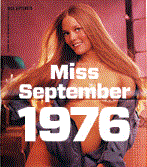
Although I had a very strong suspicion when I wrote The Paradox of Da Free John that the guru was having sexual relations with his disciples, their spokesperson at the time, Georg Feurstein, assured me in writing that it was over and that when it occurred it was part of his spiritual theatre. The facts suggest something else was going on however. Indeed, Feurstein was naively trying to gloss over his guru’s transgressions by trying to put a “spiritual spin” on what was obviously unethical behavior for a normal person, much less a master who claims to be God-realized. Later Feurstein tried to come clean about Da Free John when he left the group in the late 1980s. In his book, Holy Madness, Feurstein tries to come to grips with Da’s crazy wisdom approach. Feurstein’s effort, however, falls way short, since he does not reveal in-depth the scandal that hit the community or explain his own questionable actions at the time.
In retrospect, I think The Paradox of Da Free John is much too kind to the guru. True, Da Free John (now Da Avabhasa) remains a vitally interesting cult leader, but he has become so emeshed in his own ego trip that it is nearly impossible for the reader to wade through his self- aggrandizing tirades and discover the rare philosophical jewel from time to time.
Furthermore, the unmitigated hype surrounding him and his mission has reached absurd levels, especially when someone as bright as Ken Wilber has the audacity to claim that Da Free John is the greatest spiritual master of all time and that his book, The Dawn Horse Testament is the greatest spiritual tome of all time. To be sure, Da has written some brilliant pieces, but to then extend beyond his writings into an ontological appraisement of his status in the universe not only seems completely arbritary, but downright silly. One gets the impression that we are talking about comic book action heroes. Who is greater: Superman or Batman? Or, as Wilber would have us frame it: Da or Jesus?
Well, the debate is entirely missing the point, something which Wilber has yet to come to grips with: brilliant writing does not make one a saint. In fact, a great thinker may live a reprehensible life; and if the published reports of Da Free John are any indication of his personal integrity, then he ranks along with John-Roger, Thakar Singh, Paul Twitchell, and others, as a charlatan more bent on satisfy-ming his personal whims than helping his disciples achieve their spiritual goal.
I say all of this in the context of someone who likes to read Da Free John’s books. Da Free John is clearly a more important thinker than most of the cult leaders today, but that does not mean that we have to condone his mean spiritedness and immature taunts under the lame excuse of “Holy Madness.” My sense is that if we leave out the adjective “Holy” we will get much closer to the truth behind Da Free John.
NOTES
1. There is a tendency when reading Alan Watts to presume that Enlightenment is an intellectual process; conceptually understand the ultimate truths of the universe and Self- Realization naturally occurs. This is not correct since genuine spiritual awakening involves the entire body-mind- soul complex. To intellectualize about Nirvana or Satori is quite easy, but to actually transform and surrender one’s self to the Supreme Reality is a very difficult task indeed.
For glimpses into Alan Watts’ own trials and errors, see his autobiography, In My Own Way.
2. Although it is true that rituals have their place in setting up the right context for religious functions, it should not be forgotten that the essence of such superstructures, as Frits Staal (Exploring Mysticism) terms them, is to reveal (not conceal) the sacred mystery.
All too often organized religions overlook their vital and primary purpose and begin to serve as social institutions concerned with purely ethical issues. It should also be pointed out here that not every seeker is attracted to a spiritual movement by means of the teachings. As Georg Feuerstein makes clear about the Johannine Daist Communion: “In our experience, people frequently join our Community not because of the Teaching but because of their response to the Spiritual Master. (They may have seen a photograph of the Adept or a video and subsequently read some of the literature.) The way in which potential devotees are “contacted” by the Adept is mysterious, and no reductionistic explanation can do justice to what has actually happened in hundreds of cases and is continuing to happen to newcomers even now. This is not to deny that for many people the Teaching itself is inherently attractive, but we find that the Teaching literature is read by very many people who have made no attempt to take up this Way, presumably because they do not associate its attractiveness with the spiritual presence of the Adept. And those who are content to merely read the literature, many suffer from the illusion that reading Master Da Free John’s works is a sufficient form of spiritual practice. They belong to what the Adept calls the `talking school’.”
3. In the M.S.I.A.’s world-view (i.e., John-Roger’s novelistic creations), “The Mystical Traveler of Consciousness” is a force which has always been present on earth.
4. The history of M.S.I.A. is in many ways the life story of its founder, John-Roger Hinkins. John-Roger not only attempted to hide things about his past and cover-up his nefarious sexual activities, but he has also tried to set up phony smear campaigns against his detractors. See “The J.R. Controversy.”
5. The term “naive bumpkin” comes from Da Free John, as quoted by Georg Feuerstein in his Introduction to Nirvanasara (Clearlake: The Dawn Horse Press, 1982), page 8.
6. The cause for this change in attitude, I suspect, among disciples of Indian gurus has more to do with the student than with the teacher. For instance, when I was in India in 1981 I noticed that one Swedish seeker judged the greatness of a guru by how much time he gave to him personally. The result? If the master spent lots of time with him, he was a highly evolved teacher. If the master spent little or no time with him, he was still a struggling soul.
7. The bottom line in discipleship is that the student can never fully accept intellectually that his master is perfect. Hence, every absolute verdict or judgement that is made is always doomed to change or be radically altered. In this way, how a devotee sees his guru is to a large degree a reflection of his own inner struggle or advancement. However, there is also a certain element of constancy to a disciple’s perspective, especially if they are mature practitioners. As Georg Feuerstein elaborates: “I can readily see that in a certain mood the Guru will appear to a disciple in his transcendental nature, and in another mood the Guru will appear to him very mundane. But beyond these moods of the disciple, there is also a genuine heart intuition of the Guru’s true nature which allows the disciple to understand his varying `readings’ of the Adept-Teacher as projections. And that intuition deepens with his spiritual maturation, until the Guru is recognized to be literally identical to himself (or his Self), as the transcendental Being.”
8. Since the tragedy of Jonestown there has been a great “cult scare” in America where any non-mainstream religious movement is suspect. In fact, though the word cult by definition is not pejorative it has become the mass media’s buzz word for the religiously off-beat. This is unfortunate because there are a number of “cult” leaders who have some very insightful things to say about man, society, and God. Of course, this is not to overlook the glaring truth that many religious leaders are misguided or even dangerous.
9. The preceding quotations were selected from letters and interviews taken in the last ten years on the subject of Da Free John. Georg Feuerstein strongly objects to this type of “journalistic” writing on my part. Comments Feuerstein:
“[This section] is odious to me personally, because it promotes journalistic sensationalism. I merely want to comment on one point: The reason why Master Da Free John wears so many different hats is that all of them represent gifts from devotees, and he is wearing them for their sake, just as all his clothes are made and supplied by devotees. Without the notion of an Adept’s perfect self-sacrifice, these gestures remain unintelligible. They are visible signs and the Adept is affirming his relationship with individual devotees– constantly.”
10. Most of the anti-cult organizations today are religiously based. It is from a theological framework (usually Biblical) that such groups attack wayward religious movements, especially those which do not subscribe to their cherished world-view. Again, I think this is a mistake. Even though we should be critically minded when studying new groups (as well as “old” ones), it is improper to dismiss penetrating ideas and thoughts simply because they do not fit into our own preconceived models of reality.
11. I would like to add that this particular student was exceptionally bright and went on to read parts of The Paradox of Instruction, as well as Ken Wilber’s Eye to Eye. To the chagrin of my teacher associate, with whom I was a friend, the student won a major literary scholarship on the basis of a paper he wrote which quoted at length Ken Wilber’s thoughts on the “perennial philosophy,” portions of which contain elaborations of Da Free John’s insights.
12. Quoted from the back cover of Da Free John’s The God In Every Body Book (Clearlake: The Dawn Horse Press, 183).
13. There is often a tremendous amount of hype in spirituality. It is not dissimilar in some ways to the reviews of new Hollywood movies. If a recognized “reviewer” raves about a film, there is a predisposition among some movie-goers to question their own tastes. “Well, the New Yorker said it was a classic, so my boredom must be due to my inability to find the deeper meaning.” Likewise, if a well-known author in philosophy claims that a particular guru or master is “enlightened” the would-be reader is more likely to buy into it. The catch here, though, is that the writer may never have met the teacher in question. Furthermore, the philosopher may have some critical comments to make about the guru, but hesitates in doing so in fear that they will not be printed. Or, if such criticism is made the publisher does not include the same in the blurbs accompanying the book. The problem in all of this is that spirituality (or the guru’s status) becomes a marketable item, polished and advertised to “look good,” to be “acceptable” for the general reader. What is needed to counteract this “glossing sheen” is for individuals to directly find out what is occurring within the movement.
14. Georg Feuerstein sees my emphasis on distinguishing between the message and the medium as limited. Elaborates Feuerstein: “You make the point about separating the message from the medium. From a worldly (objectivist) and hence limited or partial point of view this is valid. However, from a spiritual perspective this separation of message and medium is a product of the materialistic mind that is unable to perceive the psychophysical unity of the cosmos. Thus, from the Adept’s viewpoint, his Teaching is one of his Agencies and as such is co-essential with his spiritual presence and potency. His entire Teaching Argument is intended to bring people to a level of self-understanding that will then enable them to begin to relate to the Adept as Spiritual master. The Adept is the Way. But his esoteric equation is meaningless to the conventional mind that interprets reality on the basis of innate doubt and distrust. I agree with you that writing well is not a sufficient criterion for appraising a Teacher’s authenticity. Master Da Free John is manifestly a marvelous writer, but his writings (most of which are in fact printed talks) have a communicative power that goes beyond niceties of style.”
15. I owe this discussion of authenticity and legitimacy to the pioneering work of Ken Wilber. See A Sociable God and Eye to Eye for more information.
16. Georg Feuerstein and I disagree over the issue of legitimacy as a necessary criterion. My own feeling is that unless the master’s actions are above suspicion on this plane, it is not wise to follow him in the spiritual planes.
In other words, if you cannot trust the guru in the ordinary waking state, what assurances are there that he should be trusted in the spiritual worlds? Georg Feuerstein believes that the concept of legitimacy, as it is presently used, lacks sophistication, particularly in relation to authenticity. Writes Feuerstein: “Your comment that the `authenticity of a religious teacher, though partially open to rational appraisements, is determined by the personal engagement of the student’ is to the point. Precisely for this reason the sort of treatment attempted by you is of limited import. Its hermeneutical methodology necessarily suffers the limitations of the `outside’ observer. Also, your sharp separation of authenticity from legitimacy is artificial. For instance, Jesus’ well-known outburst of righteous anger at the money lenders in the temple cannot be legitimized other than by his authenticity as a Spiritual Master. If we assume he was less than an Enlightened Adept, then this act was egoic and not self-transcending, and the spiritual Principle cannot be thought to have been upheld by him in that case. Then the question of the legitimacy of his behavior can be appropriately discussed within the context of Hebrew mores. If, however, we see Jesus as an Adept, then his action immediately takes on a different significance. He may have acted out of keeping with standard behavior at a holy site, but a larger, spiritual Principle was involved that led to the immediate purification of the situation (that is, positive change in spiritual terms). Of course, the latter view only makes sense within a perspec- tive that is nonmaterialistic. And, to be sure, such a non- materialistic orientation is essentially nonconventional.”
17. It is extremely dangerous to make final judgements on any human attainment. Rather, we should always realize that our appraisements, though at times useful and necessary, are subject to revision. Moreover, since we do not have access to all levels of existence, it would be premature to make absolute claims on the nature of reality. As S.L. Frank beautifully points out in his landmark text, The Unknowable, the paradox of life is that the moment we know something with certainty, at that very same instant we do not know it. Every appraisement, even the one that is presented here, is but a partial glimpse.
18. Da Free John’s work is exceptional. Though we may disagree with his guru image or even his lifestyle, it would be a mistake not to acknowledge the power of his writings. Ken Wilber was not exaggerating in his praise when he wrote that Da Free John’s The Paradox of Instruction “is, in its scope, its eloquence, its simplicity, and its ecstatic fund of transcendent insight, probably unparalleled in the entire field of spiritual literature.” This book and others have rightly claimed an enthusiastic audience. The debatable point arises when we begin to equate superb writing/teaching with the author himself, particularly when there has been no personal contact or engagement with the guru.
19. These observations were taken from interviews and letters during the past ten years on the subject of Da Free John. Georg Feuerstein, again, disagrees with some of these comments, since he feels that they arise from a fundamental misunderstanding of the Adept and his work. Elucidates Feuerstein: “The question of legitimacy can obviously be used as a convenient instrument for the conventional mind to air its biases and presumptions. A good case in point is the whole matter of charging money for spiritual services. Money, like sex, has traditionally been regarded as being antithetical to true spiritual life. This naive view can be understood historically and psychologically. It is essentially neurotic, as is all purism. Besides, it is worth pointing out that the early Christian cult was entirely financed by its converts who had to give up all their worldly possessions! Jesus didn’t request a donation, true. He demanded that his devotees or disciples abandon the world altogether and become renunciates. Naturally, they would not leave their possessions to the state, but make them over to the growing community of followers. Master Da Free John also requests no donation. Like Jesus or Gautama before him, he expects his devotees to live as renunciates in community with one another.” Personally, I have a different view than Georg Feuerstein on this subject of money. Perhaps it is my own prejudice but I remember when I was seventeen years old and went to one of Da Free John’s (then Franklin Jones) public talks, where a group leader spoke on the teachings of his guru. The meeting was held in West Hollywood on Melrose Avenue during the beginning years of the movement (1973). Finally, after the presentation, an older woman raised her hand and asked how it would be possible to sit in formal meditation with Franklin Jones (Da Free John). The speaker answered by saying, among other things, that a donation of fifty dollars or more was necessary. Needless to say, this request for money was disconcerting to the audience that was present.”
20. This notion of self-proclamation or gurus making claims about their own spiritual attainment is a complex issue. My own sentiments are in agreement with Julian P. Johnson’s classic adage, “If any man claims to have attained the highest in spiritual development that claim of itself may be taken as conclusive proof that he has not attained so much.”
Georg Feuerstein has a different view. Argues Feuerstein: “2500 years have elapsed since Gautama the Buddha’s parinirvana. 2000 years have passed since Jesus’ crucifixion. Most of us now look upon both as truly great spiritual lights. Many regard both as fully Enlightened beings. And yet, both made personal claims about their own spiritual Realization. The New Testament is full of them, as is the Pali Canon. And let us not evade the issue by arguing that both documents do not represent the ipsissima verba of these two great Adepts. They may not give us the exact words of Gautama and Jesus but they certainly give us the gist of their Teaching and Work. Why should an Awakened being not proclaim his Realization if what is supposed to be his function is to make a visible impact on the world? Not every Enlightened being is destined to die in obscurity in a cave or a jungle. I dare say few are so destined.”
21. The island is called Naitauba and is the location of the Hermitage Sanctuary of the Johannine Daist Communion.
22. Since Da Free John changes appearance so often (or at least in the pictures accompanying his books), it is understandable why “conventionally minded” readers are put off by him. To them, Da Free John looks like a caricature of the cult leader gone eccentric.
23. See Da Free John’s Scientific Proof of the Existence of God Will Soon Be Announced by the White House! (Clearlake: Dawn Horse Press, 1980) for more on this perspective.
24. This is the inherent limitation of empiricism, rationalism, and even critical thinking. Regardless of how well we may analyze a situation when it comes to spirituality or trans-personal realms of consciousness the investigator must engage in actual transcendent practices in order to rightly and fully understand the height of a teacher or master.
This, of course, is not to say that rational scrutiny does not have its place (the existence of this book is an argument for critical thinking), but only that we eventually move away from armchair speculations into experimental engagement. Georg Feuerstein is correct, I believe, when he states that my treatment of new religious groups has “limited import,” since it suffers “the limitations of the ‘out- side’ observer.” However, even in its “limited” ability, such reports do serve a vital function in developing keen discrimination. Thus, the intellect should act as a stepping stone for further evolutionary growth, not as a barrier or hindrance.
25. I think it would be unfair to categorically dismiss Da Free John and his writings, or, to lump him with the majority of other self-styled gurus in America. At the very least, though we may be critical of Da Free John’s actions, etc., his writings do open us up to the utter Mystery and Wonder of creation. The directness of his argument is both refreshing and awakening.
——–
54. Fred Alan Wolf, Ph.D., Foreword, to Da Free John’s The Transmission of Doubt (Clearlake: The Dawn Horse Press, 1984) page 11.
55. Simply put, the major criticism of Da Free John is the “appearance” that he is on an ego trip and that his writings reflect an exclusive revelation. For instance, there are a number of books written by other masters which do not give the impression of ego, e.g., Talks With Sri Ramana Maharshi, Paramahansa Yogananda’s Autobiography of a Yogi; and Baba Faqir Chand’s The Unknowing Sage. This “impression of humility” is not due to the reader but to the style with which the masters chose to express their life and teachings.
56. Although Da Free John writes so much about the oneness of God and that Enlightenment is our true condition/heritage, his language is distinctively dualistic, replete with “I” versus “you” statements. For some readers, this stylistic preference automatically removes them from Da Free John, as his tone is often paternalistic, and, in some cases, condescending. A good example of the latter is in the question/answer transcriptions between Da Free John and his disciples.
“DEVOTEE: Bubba, you are communicating a consideration here to people who have not totally assumed it. But in the future we will be able to assume it.
BUBBA: It would seem that way, wouldn’t it? But since I can never leave, it stands to reason that you can never change. Certainly you will all become better, but that betterness will be the ordinariness of that new time.”
Bubba (Da) Free John, The Way That I Teach (Clearlake: The Dawn Horse Press, 1978), page 243.
57. “Pondering and Preparation,” An Essay by Da Free John, August 25, 1984, The Laughing Man Magazine (Volume 5, Number 3), page 81. My personal problem with this particular essay, besides the overuse of “Me” and “I,” is that the overall thrust of Da Free John’s invitation involves some type of monetary subscription. For example, to be a “Friend” of the Johannine Daist Communion one should contribute $70 or more and subscribe to The Laughing Man Magazine. This continued emphasis on money as a prerequisite for “formal association,” beginning in the early 1970’s when a donation was expected for sitting in meditation with Franklin Jones (Da Free John), undermines the legitimacy of Da Free John’s presentations.
58. James Steinberg, “Avadhoots, Mad Lamas, and Fools: the Crazy Wisdom Tradition,” The Laughing Man Magazine (Volume 3, Number 1), page 68.
59. Ibid., page 101.
60. Richard Grossinger, East-West Journal (November 1984), page 78.
61. Concludes Georg Feuerstein: “One final point: Although the Crazy Wisdom Adept constantly deals with the conventional mind of those who aspire to spiritual practice in his company, he NEVER pushes anyone beyond the point where he or she ceases to relate to the test with real understanding or self-insight, true surrender to God, actual reception of the Spirit-Current, etc. Besides, the disciple is always free to NOT participate, even in a verbal confrontation. The mark of the true Adept is that he will set his disciples free, not bind them. But it is a mistaken popular notion that spiritual life is all sweetness and delight. It is a profoundly difficult struggle, an ordeal of constant self-transcendence. The other mark of any Adept worth his salt is that he will always provoke a spiritual crisis in his disciples or devotees.